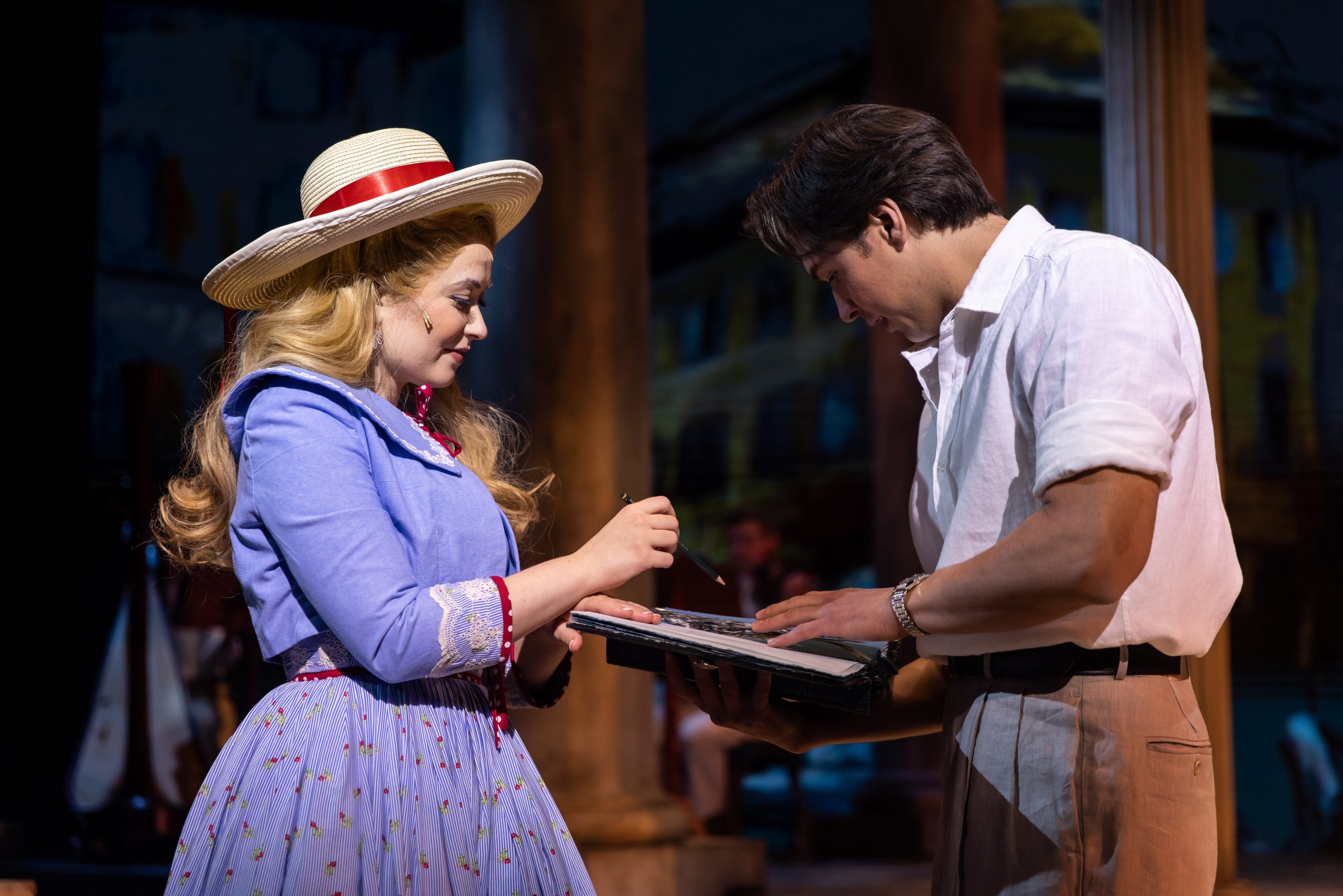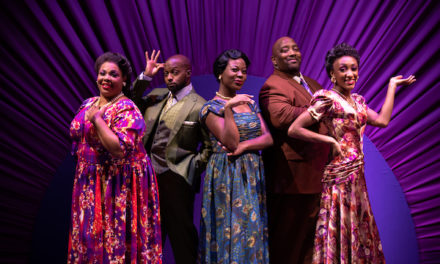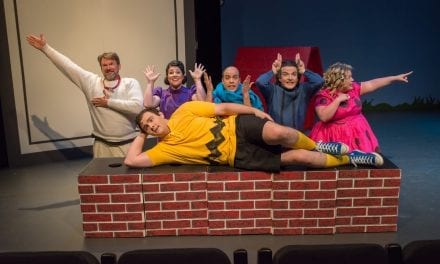SANDY — The display screens outside the Sorensen Legacy Jewel Box Theatre indicated how the Italian setting of the Tony award winning play The Light in the Piazza by Craig Lucas and Adam Guettel had inspired other romances such as Romeo and Juliet. That simple tidbit served as all the context I needed to get a sense of what the story would hold. There would be romance that had potential for tragedy. There would be Italian. The essence of the story is really those two things, but in that simplicity, lives a beautiful, heartfelt narrative that was masterfully told by cast and crew alike.
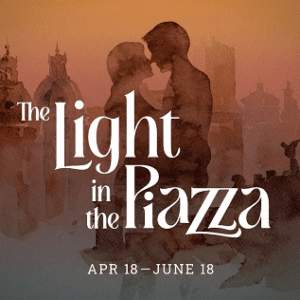
Show closes June 18, 2022.
The Light in the Piazza begins with southern belle Clara Johnson (played by Jessica Sundwall Hudson) visiting Florence, Italy, with her mother Margaret (played by Jennifer Hohl). Margaret is engrossed in recalling the romantic scenes of her honeymoon trip to Florence while Clara is sketching, taking in the city, and playing whimsically in the street. Her mother tries unsuccessfully to regain her attention with humor and southern charm. A sudden gust of wind blows Clara’s hat off her head and into the waiting arms of handsome Italian shopkeeper Fabrizio Naccarelli (played by Ren Cottam), which sparks an instant attraction that felt authentic in its total lack of guile. Through the remainder of the play, Margaret seeks to keep Fabrizzio and Clara apart with little success due to Fabrizzio’s persistence and Clara’s aloof disinterest in her mother’s protestations.
The relationships Clara has with her mother and Fabrizzio were enchanting due to the stellar acting of Hudson, Hohl, and Cottam, as well as the strong direction and choreography of Dave Tinney. The romance between the young lovers is a whirlwind of chance meetings, sidestepping parental objections, and late night stolen encounters. Through all of it, the romantic tension was strong while remaining innocent and sweet. Hudson and Cottam found numerous ways to have little bits of contact and hold one another in a variety of ways that made the romantic inside me swoon just a little.
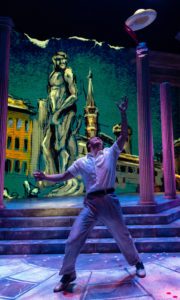 Hudson also played off of Hohl in a mother daughter dynamic that was one moment heartwarming and the next heart wrenching. Hohl and Hudson have a playful banter that had me laughing far more in a romance than I anticipated. The two worked in tandem to find each piece of the text that would enrich their relationship through humor, and I found myself consistently chuckling at the ways the two played off of one another. The two interact with the world of Italian art as Clara sings about the land of naked marble boys, and Margaret keeps up with amusement at all there is to try to remember about her own love in Florence so long ago. Eventually Fabrizzio takes the Johnsons to meet his own family who are charming and welcoming. As they meet and interact it becomes clear that no one’s relationship is ideal. Fabrizzio’s parents (played by Jared Lesa and Melinda DeBirk) may have turned a blind eye to infidelity in their own marriage while Fabrizzo’s brother Guiseppe is a known philanderer whose wife is perhaps too interested in Fabrizzio. Despite these strained relationships, they adore Clara and encourage their romance. Margaret, however, still resists.
Hudson also played off of Hohl in a mother daughter dynamic that was one moment heartwarming and the next heart wrenching. Hohl and Hudson have a playful banter that had me laughing far more in a romance than I anticipated. The two worked in tandem to find each piece of the text that would enrich their relationship through humor, and I found myself consistently chuckling at the ways the two played off of one another. The two interact with the world of Italian art as Clara sings about the land of naked marble boys, and Margaret keeps up with amusement at all there is to try to remember about her own love in Florence so long ago. Eventually Fabrizzio takes the Johnsons to meet his own family who are charming and welcoming. As they meet and interact it becomes clear that no one’s relationship is ideal. Fabrizzio’s parents (played by Jared Lesa and Melinda DeBirk) may have turned a blind eye to infidelity in their own marriage while Fabrizzo’s brother Guiseppe is a known philanderer whose wife is perhaps too interested in Fabrizzio. Despite these strained relationships, they adore Clara and encourage their romance. Margaret, however, still resists.
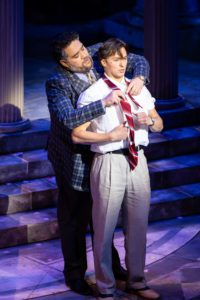 In the story, Clara sustained a traumatic brain injury in her youth that stunts her cognitive development and fills Margaret with terror that someone is going to steal away and take advantage of her beautiful but seemingly incapable daughter. Moreover, Clara’s father, Roy, is emotionally distant but demands that Margaret put a quick end to the budding romance. Hohl navigates this complicated character as if it were her own nature. Hohl’s southern accent is distinct and comedic without being overdone or farcical. She finds the humor in the character, but Hohl never lets the portrayal ignore the true feelings underlying the mother protagonist. It’s clear at the end that it is truly her story, and through it we see Hohl wish for deeper love with her husband, fear for her daughter, and eventually let her go to experience the bitter or sweet that may await her. It was an incredible portrayal of a mother who knows the dangers her daughter’s heart will face, and Hohl still convinces us that the conclusion is to let her go.
In the story, Clara sustained a traumatic brain injury in her youth that stunts her cognitive development and fills Margaret with terror that someone is going to steal away and take advantage of her beautiful but seemingly incapable daughter. Moreover, Clara’s father, Roy, is emotionally distant but demands that Margaret put a quick end to the budding romance. Hohl navigates this complicated character as if it were her own nature. Hohl’s southern accent is distinct and comedic without being overdone or farcical. She finds the humor in the character, but Hohl never lets the portrayal ignore the true feelings underlying the mother protagonist. It’s clear at the end that it is truly her story, and through it we see Hohl wish for deeper love with her husband, fear for her daughter, and eventually let her go to experience the bitter or sweet that may await her. It was an incredible portrayal of a mother who knows the dangers her daughter’s heart will face, and Hohl still convinces us that the conclusion is to let her go.
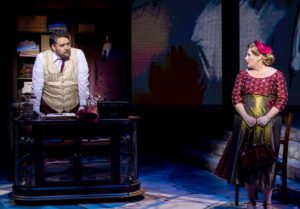 Tinney navigates these heavy themes so well. In what could be a yawn filled musical with complex themes, language I don’t understand, plot that is character driven, and music that is gorgeous but not snappy, Tinney finds little ways to help every character matter. Each character knew their relationship to one another, and no one felt extra on stage at any time. While the play deals with mental illness, adultery, fracturing relationships, and forbidden love, it still manages to feel light, airy, beautiful, and full of life. In one scene, Clara is a lost woman whose mental deficiency could make her prey in a foreign and unknown land. The whole scene is tense without being stressful, and allowed me to understand the stakes without losing the warmth of the rest of the story. Ultimately, the heavier themes were buoyed with an added focus on hope, romance, reconciliation, and tightening of family bonds.
Tinney navigates these heavy themes so well. In what could be a yawn filled musical with complex themes, language I don’t understand, plot that is character driven, and music that is gorgeous but not snappy, Tinney finds little ways to help every character matter. Each character knew their relationship to one another, and no one felt extra on stage at any time. While the play deals with mental illness, adultery, fracturing relationships, and forbidden love, it still manages to feel light, airy, beautiful, and full of life. In one scene, Clara is a lost woman whose mental deficiency could make her prey in a foreign and unknown land. The whole scene is tense without being stressful, and allowed me to understand the stakes without losing the warmth of the rest of the story. Ultimately, the heavier themes were buoyed with an added focus on hope, romance, reconciliation, and tightening of family bonds.
So much of the support for this storytelling came through superb projections and lighting. Each time a character had an aside for the audience, the lights would change to allow the character to step away from the world of the play and let the audience in on a secret only to return naturally to the continuing story. While my other reviews show that Hale has the capacity to truly rock out, that wasn’t necessary here, and Marianne Ohran’s lighting was as simple as it was beautiful. The projections, however, were both stunning visually, and crucial to the storytelling. It was a masterclass on world and set building by Madeline Ashton. Cityscapes were drawn behind the actors through projection as scenes developed as if coming straight out of Clara’s head and sketchpad. They would change and evolve to show different locations that the revolving stage would transport the actors to. It was at times as engaging to watch as the acting itself and is something I found myself reflecting on again and again after the show ended. The only downside to it was that the theatre’s seating arrangement makes it difficult for a large number of audience members on the outer edges and upper rows to get the full effect, but that has more to do with seating than staging and impacted other production elements as well.
The story ends with Roy determined to fly out and put a stop to Clara and Fabrizzio’s hasty marriage, but Margaret ensures that the wedding continues, because romance is always worth taking a chance on. Even with a wedding, the costuming designed by Joy Zhu was tasteful and uncomplicated. The many changes of location were crisp and clean which is a tribute to both scenic designer Jenn Taylor and Production Stage Manager Susan Kupferer, as well as the entire backstage crew. It was a production that was as simple as it was beautiful, and it was a high degree of both. Like the sun poking through the clouds, The Light in the Piazza at Hale was a majestic spectacle that I will always want to pause and take in when given the chance.

These reviews are made possible by a grant from the Salt Lake County Zoo, Arts, and Parks program.

